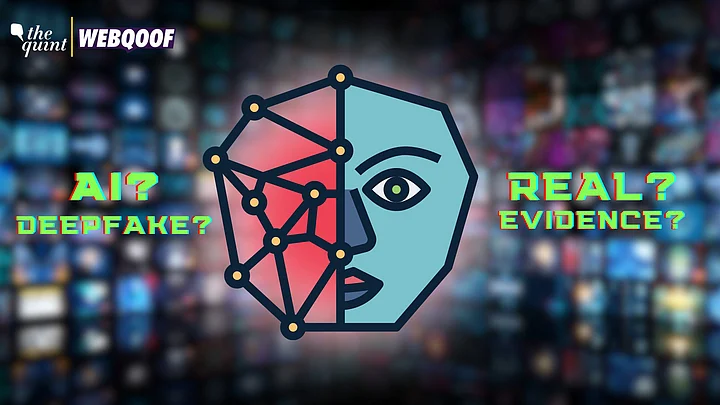When a video of two women playing with Holi colours inside a Delhi Metro went viral, the Delhi Metro Rail Corporation tried to shrug off responsibility by alleging that "deepfake technology may have been used" to create the viral video.
Deepfake videos are synthetic media made with artificial intelligence technology that try to portray something that isn't true.
In this case, however, the video was authentic and was created by a content creator named Preeti Morya. Fact-checkers, including, The Quint's WebQoof team, were able to find enough evidence to prove that the girls did shoot the video inside a Delhi metro.
This wasn't the first instance when a public figure used technology as an excuse to evade accountability. Earlier in March, when the Bharatiya Janata Paty (BJP) fielded sitting Member of Parliament (MP) Upendra Singh Rawat from the Barabanki seat, an "objectionable" video of him went viral.
Rawat withdrew his nomination, however, filed a complaint against unknown people for sharing the "doctored" and "fake" video.
Another such controversial story was about Palanivel Thiaga Rajan, also known as PTR, who served as the former finance minister in MK Stalin's government in Tamil Nadu.
In April 2023, Tamil Nadu BJP chief K Annamalai released two audio clips to claim that PTR was making allegations against Stalin's family members and the Dravida Munnetra Kazhagam (DMK) leaders while praising the BJP.
However, PTR denied the veracity of the recording and called it “fabricated” and “machine generated.”
Rest of World, a nonprofit publication, shared these two audio clips with the Deepfakes Rapid Response Force for forensic analysis. DRRF is an initiative by Witness, an organisation that uses technology to protect and defend human rights.
The program carried three independent tests on these clips.
The analysts were not able to conclude anything about the first clip.
However, they concluded that the second clip was authentic and not a deepfake.
Rest of World also connected with DeepMedia, an AI generation and detection company, who told them that their proprietary in-house deepfake detection tool shows 87% confidence that the second clip is authentic.
Similar to the other analysis, the evaluation of the first clip was inconclusive.
From Photoshop to AI, Different Names for Same Excuse
The use of technology to dismiss facts and brush aside blame is not new. Politicians and public figures have used it much before AI and deepfake became household terms.
In 2010, when a video of controversial guru Nithyananda Paramahansa and Tamil actress Ranjitha in a compromising position went viral on the internet, he dismissed it by calling it "fake and fabricated".
Another obscene video purportedly showing senior BJP leader Parbatbhai Patel with a woman surfaced on the internet in 2021. Following this, the leader's son claimed that this was "a conspiracy to defame his father and extort money". Patel maintained that the viral video was morphed, and his face was superimposed onto the body of another man in the video.
"This phenomenon predates deepfake. Earlier in political communication, they would say there is 'propaganda' then the term 'fake news' was thrown around but since the past few years any politician is dismissing any criticism as 'mis/disinformation'. This trend is continuing now with an added factor of 'deepfake' where they discredit audio or visuals formats."Prateek Waghre, Executive Director, Internet Freedom Foundation
Waghre explains to The Quint how anything presented in a video or audio format that acts as evidence against a politician is dismissed by them.
Karan Saini, an independent security researcher, explains this to be an information hygiene and media consumption issue.
"While examples of abuse of deepfake technology are rampant, there will be cases where blame will falsely be ascribed to deepfake technology, similar to how earlier it used to be ascribed to Photoshop," he adds.
"When politicians address a deepfake, a lot of experts also look into it to find errors but on the flip side, when there is actual real evidence, how would that video be detected? This becomes a defense response that politicians can put out when evidence on wrongdoings is presented against them," he added.
The Balancing Act of Using AI For Promotions vs Malinformation
Election propaganda in India has now changed from door-to-door and street campaigns to AI-generated fake videos. Last year, just before the Telangana elections, thousands of voters received a deepfake video which depicted a sitting minister appealing to them to vote against the present state government.
Call it deceptive or opportunist, generative AI goes unnoticed in the political context. In January this year, late DMK Supremo M Karunanidhi appeared before a live audience on a large projected screen and delivered a speech on the launch of a book.
Waghre states that several such claims related to politicians and deepfake will exist amid the election season but the real question is how it will change people's perspective and decision to vote.
In 2020, BJP member Manoj Tiwari, went viral on social media ahead of legislative assembly elections in Delhi after he used a deepfake video for campaigning purposes.
In the original video Tiwari talks in English, criticizing his political opponents and asks voters to vote for the BJP. Another video has been manipulated using deepfake technology to show that he is speaking in Haryanvi.
More recently, an AI generated audio clip of All India Anna Dravida Munnetra Kazhagam's (AIADMK) late leader J Jayalalithaa seeking support to party General Secretary Edappadi K Palaniswami for the upcoming Lok Sabha election was released by the party.
Saini asserts that consumers of media will have to think critically, or at least slowly, about what they see and hear instead of thinking of solving this issue technologically.
